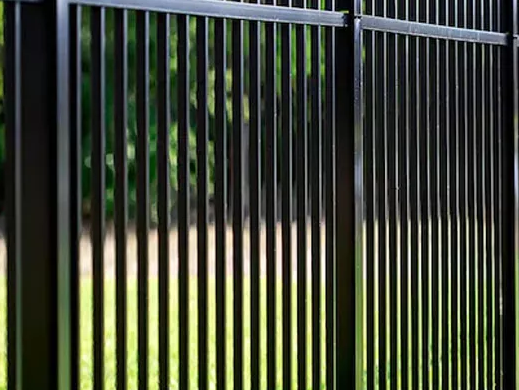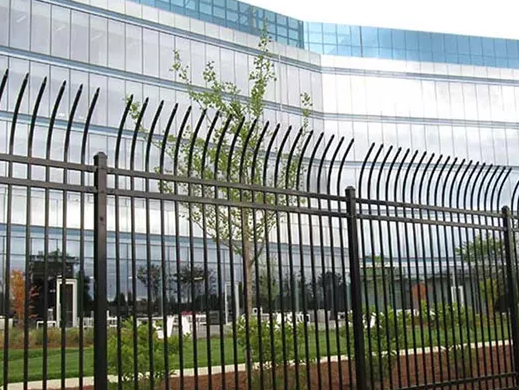
What Should You Look for In Palisade Fencing Specification Palisade fencing is a popular choice for both security and aesthetic purposes. But how do you choose the right one? The specifications of your fence can significantly impact its effectiveness. In this post, we'll discuss the key factors to consider when specifying palisade fencing, from security needs to material choices. You'll learn how to select the ideal fence that meets both your safety and visual requirements.

Key Considerations When Specifying Palisade Fencing
Security Needs
When specifying palisade fencing, it’s crucial to determine the level of security needed. Do you need a basic fence for boundary marking or a high-security option for critical infrastructure?
Features like anti-climb toppings, closer pale spacing, and thicker steel all contribute to increasing security. For even greater protection, high-security fixings and anti-tamper features can be added to prevent intrusion.
Choosing the Right Pale Profile
The profile of the pales plays a significant role in both security and appearance. Single-pointed pales are a balance between security and aesthetics, while triple-pointed pales offer greater deterrence due to their sharp design, making them ideal for high-security areas.
Round-topped pales are more aesthetically pleasing, but offer less security, making them suitable for non-sensitive areas where aesthetics matter more.
Anti-Climb Features
To prevent climbing, consider adding barbed or razor wire to your palisade fence. These toppings can make it difficult for intruders to scale the fence.
Barbed wire can be added to the top of the fence, while razor wire provides a more aggressive deterrent. Explore different topping types like Y or T extensions for additional protection against climbing.
Physical Characteristics of Palisade Fencing
Fence Height
When specifying palisade fencing, the height plays a key role in determining its security. The appropriate height will depend on your security needs—higher fences are better for high-risk areas. Regulations also vary, so check your local guidelines to ensure compliance. Fence heights typically range from 2400mm to 3600mm. The taller the fence, the more secure it is, but it may impact the aesthetic look of your property. Higher fences can appear intimidating, so it’s essential to balance security and visual appeal.
Pale Size and Spacing
The height and spacing of the pales directly affect the fence’s security. Taller pales and closely spaced ones increase the difficulty of climbing, providing better deterrence against intruders.
Generally, palisade fencing with closely spaced pales offers more protection. For areas requiring high security, the pales should be tightly spaced, leaving little room for someone to slip through. Typical spacing varies, but closer spacing provides a more effective deterrent.
Material Selection
Steel is the most commonly used material for palisade fencing, especially for high-security applications. It offers greater strength and durability compared to wood, making it ideal for critical infrastructure protection. Hot-dip galvanization is a popular method for protecting steel from corrosion. This process adds a protective layer to the steel, ensuring it lasts longer even in harsh weather conditions. By selecting high-quality steel, you ensure that your fence is strong, long-lasting, and resistant to wear and tear.
Finish Options
The finish of the fence plays a critical role in both its durability and aesthetics. A well-applied finish can protect the material from rust, corrosion, and wear.
Powder coating is a popular choice for providing a smooth, attractive surface and offering excellent corrosion resistance. It also enhances the fence's appearance, providing a long-lasting, weather-resistant finish. If you prefer a more natural look, a simple galvanized finish might suit your needs, though it may not offer as much protection against the elements.
Installation and Maintenance
Gates and Fittings
When installing palisade fencing, it’s crucial to select gates and fittings that align with the security level of your fence. The right gate can ensure the overall integrity of the system. Make sure to choose gates with durable frames and reliable locks.
Common fittings include hinges, latches, and high-security bolts. For enhanced security, consider gates equipped with anti-tamper fixings to prevent easy removal. This ensures the safety of your property and keeps intruders at bay.
Ground Preparation
Proper ground preparation is essential for installing a secure palisade fence. Ensure the ground is level and firm to provide a stable base for the posts. If the ground is uneven, additional work, such as digging deeper or using longer posts, may be required.
Ground conditions like slopes can affect installation. Some palisade systems, like Barkers’ StronGuard, are designed to handle slopes of up to 33 degrees without extra posts. Make sure to assess the ground thoroughly before starting installation.
Maintenance Considerations
Palisade fences, especially those with coatings or painted finishes, require regular maintenance to stay in good condition. Over time, rust or wear on the galvanization or coatings can occur, reducing the fence’s durability.
Routine maintenance tasks include checking for rust, cleaning the fence, and repainting or re-coating as needed. Regular inspections help identify any issues early, prolonging the life of the fence and ensuring it continues to provide maximum security.
The Pros and Cons of Palisade Fencing
Aesthetic Considerations
Palisade fencing, while highly secure, can appear intimidating, especially in residential areas. Its sharp, industrial look may not blend well with the natural environment.
To balance security with aesthetic appeal, consider using visually softer profiles. Rounded or notched pales can make the fence look more appealing, making it more suitable for residential or scenic settings without sacrificing security.
Cost Implications
Palisade fencing typically costs more upfront than standard mesh systems. However, the higher initial cost is offset by lower maintenance and repair costs over time.
Unlike mesh fences, which may require frequent repairs, palisade fences last longer due to the durable materials used, making it a wise investment for long-term security. The robust steel structure reduces the need for ongoing maintenance.
Fixing and Security Weaknesses
A standard palisade fence can have vulnerabilities, such as removable pales or weak fixings. These weaknesses can be exploited by intruders, compromising the security of your property.
To prevent these issues, choose advanced fixings and fasteners. Tamper-resistant bolts and specialized high-security fixings ensure the fence remains intact and secure against any tampering efforts. This strengthens the durability and effectiveness of the entire fencing system.
Choosing the Best Palisade Fencing for Your Needs
Understanding the Accreditation Standards
When selecting palisade fencing, it's essential to ensure it meets industry standards for quality and security. Several certification bodies evaluate fencing systems to guarantee they provide the necessary protection.
LPCB (Loss Prevention Certification Board): This board ensures products meet high standards for security and fire prevention. It’s widely recognized, especially for protecting critical infrastructure.
NPSA (National Protective Security Authority): NPSA certifies products for use in government facilities, ensuring they meet national security guidelines.
ASTM (American Society for Testing and Materials): An international organization, ASTM certifies products based on global standards for safety and durability.
Additional Insight: Always check for accreditation to ensure the fence meets the highest quality and security standards, especially if you’re protecting sensitive or critical areas.
How to Choose the Right Manufacturer and Installer
Why selecting a reputable manufacturer matters for quality and longevity
Key features to look for in an installer
Tips for ensuring proper installation and long-term performance
Additional Insight: Opt for manufacturers with industry certifications and proven experience in high-security fencing solutions.
Palisade Fencing Toppings and Security Enhancements
Barbed and Razor Wire
Barbed and razor wire are commonly added to palisade fencing to enhance its security. These toppings act as a strong deterrent, making it much harder for intruders to climb or cut through the fence.
When adding these toppings, it’s important to ensure they are properly installed. They should be placed at the top of the fence or along the fence line to prevent easy access. Choosing between barbed wire and razor wire depends on the level of deterrence required. Razor wire is more aggressive and difficult to manipulate, while barbed wire is less severe but still effective.
Additional Insight: Both barbed and razor wire can be easily added to Y or T extensions, giving extra protection and visibility.
Additional Security Features
For areas requiring maximum security, electric fence extensions can be added to palisade fencing. These electrified barriers provide an added layer of protection, discouraging anyone from attempting to breach the fence. Other advanced security features, such as CCTV cameras, motion sensors, or alarm systems, can be integrated with palisade fencing. These systems add an extra level of monitoring and protection for high-risk areas.
Additional Insight: Electric fence extensions offer increased deterrence, especially in locations where high-security is a top priority.
Conclusion
In this article, we covered key factors to consider when specifying palisade fencing, such as security, material, and installation. Choose a fence that balances security needs and aesthetic appeal.
For custom specifications, consult professionals to ensure the best choice for your property. Make sure your fence meets both safety and visual requirements.
Frequently Asked Questions (FAQ)
Q: What is the purpose of palisade fencing?
A: Palisade fencing is used for security, privacy, and demarcating boundaries, providing a physical barrier against intrusion.
Q: What are the different types of pales used in palisade fencing?
A: Pales can be single-pointed, round-topped, or triple-pointed, each offering different levels of security and aesthetic appeal.
Q: How do I choose the right fence height?
A: The fence height should match the security requirements of your site. Higher fences are better for high-risk areas. Heights typically range from 2400mm to 3600mm.
Q: Can palisade fencing be customized?
A: Yes, palisade fencing can be customized with different pale profiles, finishes, and toppings like barbed or razor wire for enhanced security.
Q: How do I maintain palisade fencing?
A: Regular maintenance includes checking for rust, cleaning the fence, and repairing any damage. Hot-dip galvanization and coatings help minimize maintenance needs.













